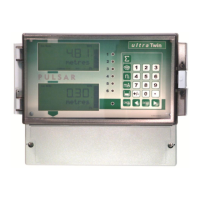Page 59
Example 1 Sump Control (pump down)
A sump is typically used to temporarily hold water or effluent, and when the
level reaches a specific point, the sump is pumped down, with the fluid
being transferred to another process.
The application is to be assigned to Point (transducer) 1.
In this example, there are two pumps, which will be set to alternate duty
assist, so they come on alternately. Pump 1 is to be set to Relay 1, Pump 2
to Relay 2, and the high level alarm to Relay 5.
This will operate as follows. During normal operation, pump 1 will come
on at 3.0 feet, and pump down to 2.0 feet. The setpoints are then shifted to
pump 2, which will come on first next time.
During peak periods, when pump 1 cannot cope, pump 1 will come on at
3.0 feet, pump 2 will come on at 5.0 feet, and pump down to 2.0 feet. The
setpoints are then shifted to pump 2, which will come on first next time.
If neither pump can cope, and the level rises to 8.5 feet, then the alarm relay
(Relay 5) will come on, and go off when the level falls to 8.0 feet. This will
indicate insufficient capacity of the pumps. The display will show the level
in the sump and mA output 1 will be representative of level where 4mA =
empty level (0%) and 20mA = 10.0 feet (100%)

